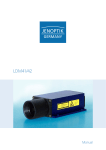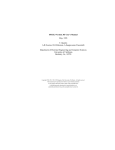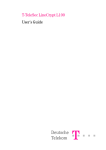Download Add Some Spice To Your Analog Designs
Transcript
stating this book's raison d'etre, both in the preface and first chapter, and indeed, throughout the book. Simply stated, Spice can be extremely difficult and frustrating when the reasons behind a failure to run or a nonconvergence aren't at all obvious. As the saying goes, "Not user-friendly." In fact, a ^Phis month's column takes a look at are ones that you'll find useful. balky Spice program can evoke a feelI some books with high EE interRon Kielkowski of RCG Research ing that all such computer operations I est, specifically a couple on Spice Inc., has been presenting a series of are best left to masochists. (Simulation Program with Integrated three-day workshops on MicroSim's But, the goal of a design simulation Circuit Emphasis).1 As the name im- PSpice since 1993, and he seems to is to learn more about how a circuit plies, Spice was originally developed have furnished at least some of the performs. Sometimes it may take furspecifically for 1C design, but has long- answers.2 He has written two Spice- ther effort on the part of the designer since been used much more generally. related books, which are oriented to to first learn how the simulator Today, the many Spice variants are the SPICE2G.6 version, the most works. At which point, he or she is considered general-purpose elec- widely used (and also the last For- better equipped to give it the correct tronic circuit design tools, but they tran-based) Spice release from the input, so that Spice can then produce are also used in broader ways, such as University of California at Berkeley. the expected and desired output. They are reviewed below. control system design. This is the basic premise of Inside Inside SPICE: Overcoming the Ob- SPICE, that is, once you better underWithout question, the capabilities of early Spice simulators have been stacles of Circuit Simulation, 1994, stand how Spice works internally, greatly enhanced. Spice today pro- ISBN: 0-07-911525-X, is a $50.00,188- you'll be much better able to make it do vides many powerful and useful fea- page, 6- by 9-in. hardcover your bidding. You can then tures, such as Monte Carlo and worst- book with six chapters, 200 ilavoid the "obstacles," which case analysis, circuit optimization, lustrations, an index, and a are those items Kielkowski sophisticated display, and graphical 3.5-in. floppy diskette with lists as often causing simulaoutput features, etc. Currently, some programs. It is available from tions to fail. These are the topsimulation packages go so far as to of- McGraw-Hill [wiow.mhhe. ics of Chapters "Nonconverfer a completely integrated design com/engcs/electrical/, or (800) gence," "Numeric Integration," and "Timestep program suite. They include 262-4729]. SPICE: Practical Device Control." schematic capture and pc-board layout tools, in addition to the basic sim- Modeling, 1995, ISBN: 0-07As a preface to appreciatulator. And, quite obviously, any sim- 911524-1, is a $55.00, 272ing nonconvergence, ulator's performance is tied directly page, 6- by 9-in. hardcover WALT JUNG Kielkowski discusses the matrix math operating basis of to the power of the host machine, a book with six chapters, five Spice in Chapter 2, "Underfactor which provides today's 300- appendices, 302 illustrations, MHz-processor machines with some an index, and a 3.5-in. floppy diskette standing Circuit Simulation," and with programs. It is also available how nonlinear elements, in particular, potent computational savvy. influence convergence sensitivity. Surely it behooves the wide-awake from McGraw-Hill. Both of Kielkowski's books simply With this background, the reader is designer to be fully aware of this simulation power, so as to best harness it radiate the fact that he is deeply in- ultimately ready to absorb the topics for his/her designs. This awareness, volved with his topics, and knows of the three obstacle chapters, and in turn, implies some measure of un- them thoroughly. One clear example of more fully appreciate all of the userderstanding of how Spice and Spice- this is the fact that he distributes his adjustable Spice settings which can like simulators work. And, here's very own 32-bit, PC-compatible influence a simulation. The book conwhere the well-focused and well-doc- SPICE2G.6 program along with the cludes with a chapter on the various umented experiences of others can two books. This program is RSPICE, Spice option settings that are availas well as RGRAPH, a graphical able. aid greatly. One should appreciate that this Spice books: If you are like me, processor. These programs and other you've probably noticed that there specialized utilities are used as live Spice book goes far beyond a typical are a lot of books out there on Spice demos, in conjunction with the book, user's manual listing of the Spice stateand Spice-related simulators. You and illustrate the various points made ments and their modifiers. It does, in fact, give the reader a deeper appreciamay also have wondered just which within the text. The six chapters of Inside SPICE tion of what's going on under the Spice books are the good ones. I, myself, have wondered those same thoughts, include: "What is Spice?," "Under- simulator's hood, and offers many useand have spent money on Spice standing Circuit Simulation," "Non- ful suggestions as to how to keep books, not always finding a full mea- convergence," "Numeric Integration, things fine-tuned. The bottom line is sure of satisfaction. Nevertheless, I Timestep Control," and "Spice Op- that Inside SPICE has the potential of hope the Spice books described here tions." Kielkowski does a good job of being useful to anyone using Spice. Add Some Spice To Your Analog Designs WALT JUNG SPICE: Practical Device Modeling development of the various models in (hereafter referred to as "Modeling") the chapters of this book. Even the deals with the practical problem of get- simpler passive-part models allow ting the appropriate models to use good insight into the development, for with Spice. These models might be any example, as with a model for a real caone or more of the following passive or pacitor. This model would include a active devices, as noted by these chap- nominal capacitance shunted by a ter headings: "Practical Device Model- leakage resistance, in series with an ing;" "Modeling Resistors, Capacitors, inductance and series resistance. and Inductors;" "Modeling Diodes and Temperature-related effects can be Zener Diodes;" "Modeling the Bipolar added, by modifying both the nominal Junction Transistor;" "Modeling the capacitance and series resistance as a Junction Field Effect Transistor;" and functions of the temperature. To achieve this, Kielkowski shows "Modeling the Power MOSFET." Models are basic to the operation of us how to use an interconnected comany Spice simulator, and it isn't al- bination of controlled sources in the ways realistic to use simplistic mod- form of an Analog Behavioral Model els, even for passive parts. Why? Be- (ABM). An ABM is a subcircuit which cause almost all passive parts have can be configured to perform addiparasitic elements which modify their tion, subtraction, multiplication, and behavior with varying temperature, so on. This trick allows the temperaapplied voltage, or frequency, etc. So, ture characteristics of a capacitor to simulations which take these para- be modeled. Of course ABMs are sitics into account are more complete very useful models on their own, and and accurate. But, a snag here is that the book's Appendix D is devoted to a with some notable exceptions, few series of them. There, ABMs are compassive component vendors currently plete working entities, ready to be offer Spice models for their parts.3 applied within larger circuits. Hopefully, this situation will change But, of course, the bulk of the book for the better as time progresses. is devoted to the much more detailed Active part models are in better processes of model development for shape, because many libraries distrib- diodes and transistors—both bipolar uted with popular simulators include and FET. Familiar parts such as the IC-vendor-supplied macromodels and 1N752 and 2N2222 are used as examsimulator-vendor-generated models ples. The developmental processes for many transistors and diodes. This used give good results. situation, however, is not universal, Throughout these modeling develnor is it complete, and often a model opments, continuous use is made of may need to be developed. the supplied modeling software tools, Kielkowski's Modeling solution for as mentioned above. This technique, the unavailable model problem is to alas, brings up the one unfortunate simply roll your own (at least for those caveat which must be stated of these parts as mentioned above). To aid in two books in their present format. this process, he has developed a num- These software tools are DOS-based ber of utility programs which help to utilities, which was understandable match measured device data and for the pre-Windows 95 days of 1994. model curves, yielding a useful model But, present-day PC users are likely for a given part. His goal for the end to be using Windows 95, which makes model is one with a "5% RMS error," it rather cumbersome to use the tools with respect to the real part. as designed, with their special DIE The models developed in Modeling structure and CONFIG.SYS-loaded are subcircuits. As this name implies, ANSI.SYS driver. they are smaller domain circuits conFor test purposes, I was able to insisting of various Spice elements, both stall the RSPICE software on my active and passive as required. These Windows 95 machine, but it does not elements are interconnected to repre- run from a DOS window under Winsent, at the outer terminals, the part dows 95. It does, however, seem to being modeled with respect to dy- run just fine, after rebooting from namic changes in current, voltage, fre- Windows 95 into DOS mode. quency, and temperature. The software certainly does offer a It is a fascinating study to see the low-cost entry into Spice experi- ences. If desired, one can also purchase three levels of support for this software, at prices ranging from $29.95 to $89.95. In discussing these operating-system compatibility issues with the author, I learned that an new edition for Inside SPICE is planned for introduction sometime around March. This new edition will feature Windows 95-compatible software, so my suggestion to interested readers is watch for this update. TIP: I enjoyed reviewing these two books, and anticipate gleaning useful material from them for some time to come. And, that's speaking as one who has used Spice on and off for about 12 years. I haven't as yet, taken one of the Kielkowski Spice courses, but hope to do so in the future. In both of these books, the author's interest and dedication to the topics shows strongly. This fact is communicated to the reader with a style which is direct, clear, and no-nonsense. I can see both books becoming practical tools, and can also easily recommend them as references. Future topics: On Spice in particular, I'm interested to learn of the general appeal of simulation as a design tool. Are the current simulator tools and available models adequate for your needs? Are integrated packages (suites) of schematic capture, simulators, and pc-board design the way to go? What are the problems you see in these areas? Let's hear from you on these, or other items. Walt Jung is a corporate staff applications engineer for Analog Devices, Norwood, Mass. A longtime contributor to ELECTRONIC DESIGN, he can be reached via e-mail at: Wjung @USA.net. References: 1. L. Nagel, SPICE2: A Computer Program to Simulate Semiconductor Circuits, Report # ERL-M520, University of California at Berkeley, 1975. 2. RCG Research Inc., P.O. Box 509009, Indianapolis, IN 46250-0900, (800) 442-8272 or (317) 877-2244. 3. Tantalum Electrolytic Capacitor SPICE Models, Kemet Electronics, Box 5928, Greenville, SC 29606, (803) 963-6300.










